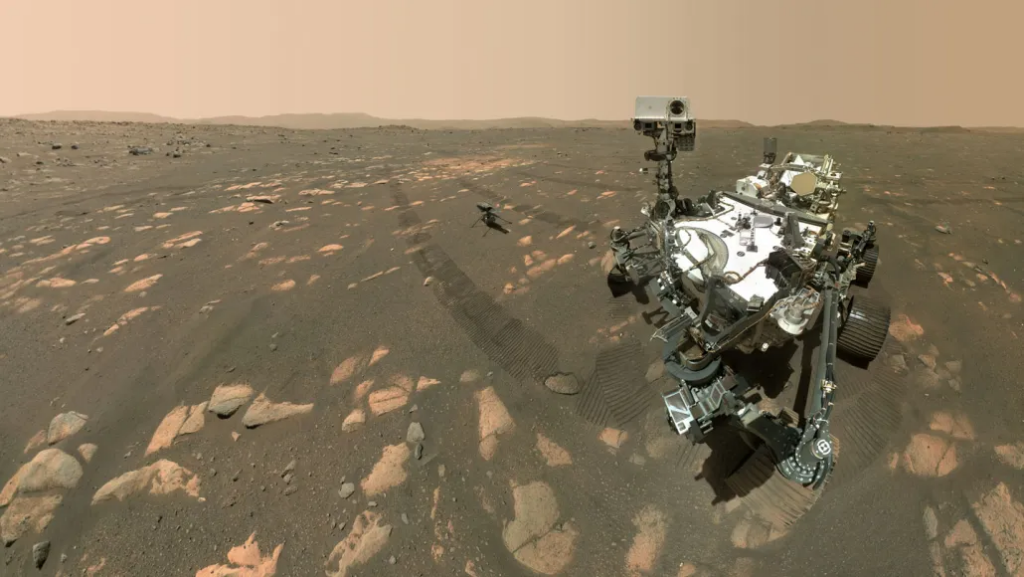These 7 findings could be game-changing but need more study

NASA’s robotic explorer, the Perseverance rover, took this selfie on Mars in April 2021. In the background stands its robotic helicopter sidekick, Ingenuity.
NASA/JPL-Caltech/MSSS
December 13, 2024 at 3:00 pm
In 2024, researchers turned up possible evidence of ancient life on Mars, hints that Alzheimer’s disease can spread from person-to-person and a slew of other scientific findings that could be a big deal — if they’re the real deal.
Martian microbes, maybe
Alien microbes may have once made their home on Mars (SN: 8/24/24, p. 6). In July, NASA’s Perseverance rover uncovered a rock on the Red Planet that sports white spots with black rings laced with iron phosphate (see Page 28). On Earth, such specks have been linked to ancient microbial life. But they’re not surefire signs of microbes. The only way to know for certain is to bring the rock back to Earth for closer inspection.

Sparking superconductivity
Light may be the secret ingredient for making superconductors that don’t require frigid conditions. In an experiment, blasting a copper and oxygen compound with a laser caused the material to throw off magnetic fields. That magnetism, the scientists say, is a smoking gun for superconductivity — the ability to ferry electricity with no resistance (SN: 8/10/24, p. 6). But skeptics contend that those magnetic fields might have arisen from some other, unknown physics.

Ancient engineering
Builders used a water-powered elevator to construct Egypt’s first pyramid nearly 4,700 years ago, researchers propose (SN: 9/7/24 & 9/21/24, p. 11). That controversial idea is based on a computer model of structures in and around the Step Pyramid of Djoser. Controlling the flow of floodwater in and out of a shaft inside the pyramid could have lifted and lowered a block-hoisting platform, the model shows. But critics argue that occasional rains wouldn’t have supplied enough water to sustain such a system.

Tectonic shake-up
Plate tectonics got off to an early start in Earth’s history, a rock in South Africa suggests. Layers in the rock bear scars of 3-billion-year-old landslides that may have been caused by an earthquake (SN: 4/6/24, p. 6). That quake, scientists say, could have been triggered by slabs of crust colliding. The finding lends support to the contested idea that plate tectonics dates back more than 2.8 billion years. But other geologists are not convinced that this quake marks the start of global plate tectonics.

Medium size, maximum hype
For the first time, astronomers may have spotted a midsize black hole in our galaxy (SN: 8/10/24, p. 7). Telescope data suggest that a black hole at least 8,200 times as massive as the sun lurks in the star cluster Omega Centauri. But another study disputes the claim. Instead, the star cluster could harbor a horde of smaller black holes (SN: 8/20/24).

Transmissible Alzheimer’s?
Alzheimer’s disease is not contagious in everyday life, but under extremely rare conditions, it may spread from one person to another (SN: 2/24/24, p. 6). Five people who in childhood received contaminated growth hormone injections later developed early-onset Alzheimer’s — most likely because the hormones were tainted with amyloid-beta, a protein whose buildup is linked to the disease, researchers say. But it’s not yet clear whether the growth hormones are to blame, other experts note. Perhaps the health conditions that those hormones were meant to treat or other medical procedures led to the development of Alzheimer’s in these patients.

Shedding light on dark energy
Dark energy may have gotten even more mysterious. The enigmatic stuff, which makes up the bulk of the cosmos, is generally thought to maintain a constant density. But new observations of 6.4 million galaxies and quasars from the Dark Energy Spectroscopic Instrument, or DESI, paired with data on exploding stars, cast doubt on that idea. These data more closely fit a model of the universe in which the relationship between dark energy’s density and its pressure changes over time (SN: 5/4/24 & 5/18/24, p. 6). If confirmed, this finding would rewrite the history of the universe. Experts are withholding judgment until DESI completes its survey of over 30 million other galaxies (SN: 12/14/24 & 12/28/24, p. 7).

Questions or comments on this article? E-mail us at feedback@sciencenews.org | Reprints FAQ
A version of this article appears in the December 14, 2024 issue of Science News.

About Maria Temming
Previously the staff writer for physical sciences at Science News, Maria Temming is the assistant managing editor at Science News Explores. She has bachelor's degrees in physics and English, and a master's in science writing.
